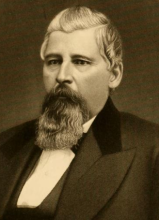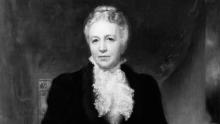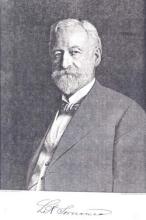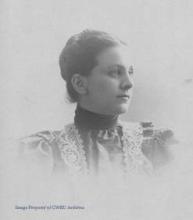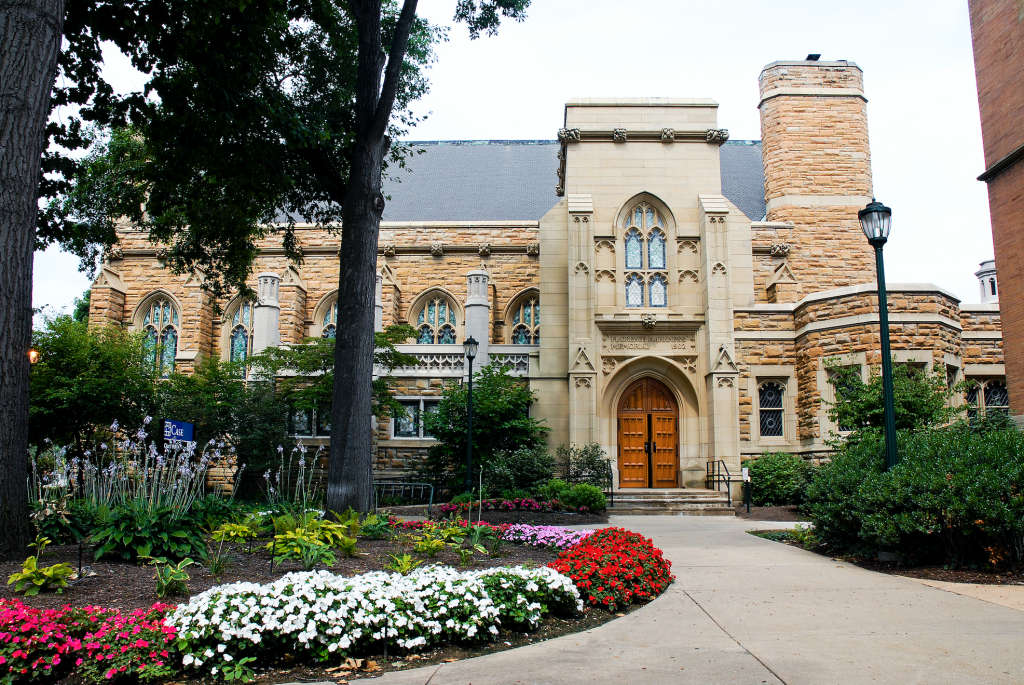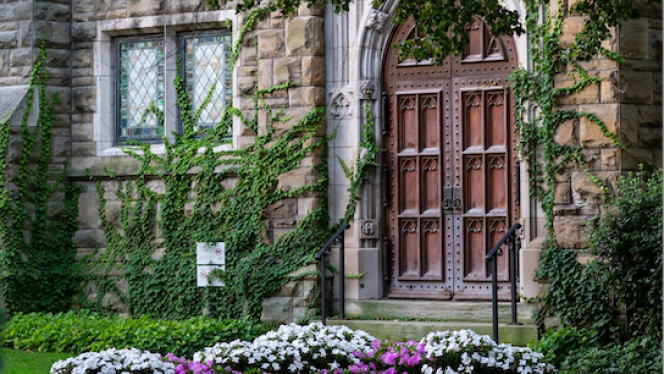
Looking to host your event in an intimate, historic space?
View Harkness Chapel on a map.
Florence Harkness Memorial Chapel at Case Western Reserve University was built in 1902 to honor Florence Harkness Severance, daughter of Stephen V. Harkness and Anna M. Richardson Harkness, and wife of Louis Henry Severance.
Designed by noted architect Charles F. Schweinfurth—famous for his work on many of Cleveland’s Euclid Avenue mansions—the chapel is a stunning example of neo-Gothic architecture. It features soaring arches, intricate woodwork, and exquisite Tiffany stained-glass windows. Located on the Mather Quad, this historic and acoustically resonant space provides a warm, intimate setting for Department of Music performances and special events.
Harkness Classroom
Harkness Classroom, located inside Harkness Chapel, serves as both a lecture hall for large classes and a backstage area during events. It is also the meeting location for the CWRU Music Colloquium Series.
Scheduling in Harkness Chapel and Harkness Classroom is controlled by the Department of Music.
Building Hours
11200 Bellflower Road Cleveland, Ohio 44106
Monday–Friday
8:00 AM–9:00 PM
Saturday/Sunday
closed (special events as scheduled)
Attending Concerts and Events
The CWRU Music Concert Series offers free performances open to the public unless otherwise noted. Can't attend in person? Watch the Harkness Chapel Livestream Channel.
Explore our Upcoming Events schedule to enjoy future concerts, student recitals, and more!
Transportation and Parking
Harkness Chapel is a short walk from the “Little Italy – University Circle” stop on the RTA Red Line, and is also accessible via regular HealthLine bus service along Euclid Avenue.
Campus Center Garage (Lot S-29)
- Location: 11172 East Blvd., Cleveland, OH 44106
- Entrance: Public entrance on East Blvd. (Bellflower Road entrance is for permit holders only)
- Cost: Daily rates up to $10 max (special event rates may apply during Cleveland Orchestra performances)
- Get Directions
Parking Lot 54 Public Parking
- Location: 1980 Ford Dr., Cleveland, OH 44106
- Cost: $1/hour (credit card payment at gate equipment, see on-site signage)
- Get Directions
Street Parking
- Metered parking is available on Bellflower Road and East Blvd.
- Please check meters for rates and time limits.
Additional Parking
Venue Specifications
| Construction & Design |
|
| Dimensions & Capacity |
|
| Performance Amenities |
|
| Lighting & Power |
|
| Climate & Accessibility |
|
| Technology & AV |
|
| Usage & Reservations |
|
History of Harkness Chapel
Built in 1902, Florence Harkness Memorial Chapel honors Florence Harkness Severance, the daughter of Stephen V. Harkness and Anna M. Richardson Harkness, and the second wife of Louis Henry Severance.
Florence’s father was a key investor in Standard Oil, serving as its second-largest shareholder after partnering with John D. Rockefeller. Her husband, Louis Severance, was also an early shareholder and later became a major Cleveland philanthropist.
A Legacy of Service and Compassion
Florence grew up among Cleveland’s elite on Millionaire’s Row, where her upbringing emphasized charitable work and civic duty.
Her favorite Sunday School teacher was Flora Stone Mather, a deeply influential figure in Cleveland's educational and philanthropic community.1
Educated at private institutions in Cleveland, Farmington (Connecticut), and Boston, Florence inherited a sizable trust fund upon her father's death. She used her wealth to support a range of causes—including missionary work, children's welfare, and the Lend-a-Hand Mission for the working poor.
Remarkably independent for her time, she lived on her own in New York City before marrying Louis Severance in 1894, shortly before her 31st birthday.
Tragically, Florence died just ten months later, in July 1895. Her funeral was held at the family’s home on Euclid Avenue, adorned with her favorite flower—roses. The cause of death was septicemia, though the precise origin remains uncertain. Florence is buried in the Harkness family plot at Lake View Cemetery.
Building the Chapel
In memory of Florence, her husband and mother funded the construction of a chapel on the campus of Western Reserve College (now part of CWRU), along with the
establishment of a Chair of Biblical Instruction under the Florence Harkness Foundation Fund.
- Architect: Charles F. Schweinfurth (designer of many grand homes along Euclid Avenue)
- Groundbreaking: June 14, 1899
- Dedication: Easter Sunday, 1902
Originally, Harkness Chapel was intended not for music, but for “the reverent and intelligent study” of the Bible by young women, as described in the dedicatory speech by Hiram Haydn.2 The structure included both a chapel and a classroom to support students’ spiritual and academic lives.
Renovations and Rededication
Harkness Chapel has undergone several major updates:
- 1918: Transept expansion, also designed by Schweinfurth and funded by Anna Harkness
- 1922: Organ rebuilt by the Austin Organ Company
- 1973: Declared a Cleveland Landmark and rededicated as a home for the Department of Music
- 1990: Stage enlarged, lighting and audio updated, organ console removed and building made handicap-accessible3
- 1994: Green velvet pew cushions donated anonymously
- 1998: Creation of the Harkness Multimedia Classroom
Today, the chapel and classroom support modern music performance and instruction. Recent preservation efforts have included refurbishing stained-glass windows, climate control upgrades, modernizing the audio recording and livestreaming systems, and enhanced stage lighting and fire safety.
Sources: CWRU Archives, Cuyahoga County records, Lake View Cemetery Association, Miss Porter’s School, and the Western Reserve Historical Society.
Footnotes
1 Flora Stone Mather (1852–1909) was a Cleveland philanthropist and advocate for social reform and women’s education. A major benefactor of Western Reserve University, she helped establish the College for Women, which was later renamed the Flora Stone Mather College. Her leadership and generosity shaped the university’s commitment to equal educational opportunities for women.
2 Rev. Dr. Hiram Collins Haydn (1831–1913) served as the fifth president of Western Reserve College (1887–1890), then located in Hudson, Ohio, before it moved to Cleveland as part of what is now Case Western Reserve University. He was also a long-time pastor at Old Stone Church (First Presbyterian Church) on Cleveland’s Public Square—one of the city’s most historic congregations. A strong advocate for women’s education, Haydn played a key role in the founding and dedication of Florence Harkness Memorial Chapel, originally envisioned as a space for the moral and spiritual formation of women students. He gave the dedication address in 1902, emphasizing the importance of “reverent and intelligent study” and the nourishment of the student’s inner life.
3 The organ pipes remain in place at Harkness Chapel. They are nonfunctional and serve a decorative and historical purpose—a visual reminder of the chapel’s original design and musical legacy. Though no longer playable, the pipes remain an iconic part of the chapel’s interior architecture.


